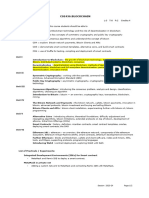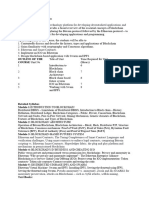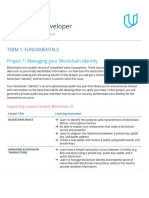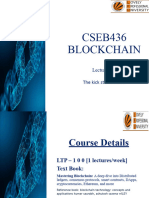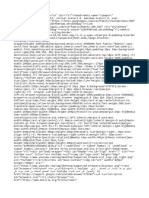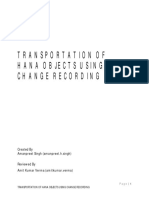BLOCK CHAIN TECHNOLOGIES LAB
IV B. TECH-I SEMESTER
Course Code Category Hours/Week Credits Maximum Marks
A6CY26 PEC L T P C CIE SEE Total
3 - - 3 40 60 100
Contact Classes:64 Tutorial Classes:Nil PracticalClasses:Nil
COURSEOBJECTIVES
The course should enable the students to:
1.To develop and deploy smart contracts on local Blockchain.
2.To deploy the smart contract on test networks.
3.To deploy and publish smart contracts on Ethereum test network.
4.To design and develop crypto currency.
5.To deploy chain code on permissioned Blockchain.
6.To design and develop a Full-fledged DApp using Ethereum/Hyperledger.
COURSEOUTCOMES
On successful completion, of course, learner/student will be able to:
1.Develop and test smart contract on local Blockchain
2.Develop and test smart contract on Ethereum test networks.
3.Write and deploy smart contract using Remix IDE and Metamask.
4.Design and develop Cryptocurrency.
5.Write and deploy chain code in Hyperledger Fabric.
6.Develop and test a Full-fledged DApp using Ethereum/Hyperledger.
BLOCKCHAIN - LIST OF EXPERIMENTS
WEEK - 1 Simulating a Simple Blockchain
P1: Design a Python program to create a block with a timestamp, data, and previous block hash.
P2: Chaining Blocks: Extend the program to create a blockchain by linking multiple blocks.
P3: Validating the Chain: Implement a method to verify the integrity of the blockchain.
WEEK - 2 Digital Signatures
P1: Demonstrate the use of digital signatures for transaction authentication.
P2: Sign a transaction using the private key.
P3: Verify the transaction signature using the public key.
WEEK - 3 Simulating Bitcoin Transactions and Double-Spending
P1: Design a Python script to create a transaction with sender, receiver, amount, and a digital signature. How would you verify the
transaction’s authenticity?
P2: Implement a simple blockchain with a proof-of-work mechanism. What happens to the blockchain’s integrity if two miners
simultaneously attempt to add conflicting transactions? Ascertain the transaction that remains valid.
�P3: Simulate a double-spend attack by attempting to spend the same Bitcoin twice in two different transactions. Propose a solution
to detect and prevent this attack.
P4: Modify the proof-of-work difficulty in your simulation. How does increasing or decreasing the difficulty affect the time taken to
mine a block?
WEEK - 4 Creating and Deploying a Token on Ethereum
P1: Write a Solidity smart contract for an ERC-20 token with functions for transferring tokens and checking balances. Deploy it on
a testnet and verify its functionality.
P2: Modify your ERC-20 token contract to include a function that restricts transfers to specific addresses. How does this affect the
token’s use in an ICO?
P3: Simulate an ICO by issuing 1,000 tokens and distributing them to five addresses. How would you ensure fair distribution in a
real ICO?
P4: Analyze the gas costs of deploying and transferring your token. Propose methods to optimize gas usage in your smart contract.
WEEK - 5 Simulating the Byzantine Generals Problem in a Distributed Network
P1: Implement a Python simulation of a network with 10 nodes, where 3 are Byzantine (malicious). How many faulty nodes can
your consensus algorithm tolerate?
P2: Modify your simulation to include a leader election mechanism. How does this affect the time to reach consensus?
P3: Compare the simulated consensus algorithm with Bitcoin’s proof-of-work. Which is more resilient to Byzantine faults, and
why?
P4: Introduce a delay in message passing between nodes in your simulation. How does this impact the consensus process?
WEEK - 6 Simple Storage Contract
P1: Create and deploy a Solidity smart contract to store and retrieve an integer value on the
Ethereum blockchain.
P2: ERC-20 Token- Develop and deploy an ERC-20 compliant token contract with functions for transferring tokens and managing
allowances.
P3: Voting Contract- Create a smart contract for a decentralized voting system where users can vote for predefined
candidates, and the owner can view results.
WEEK - 7 Wallet Development, Platforms, APIs
P1: Developing a Basic Ethereum Wallet Using Web3.js
P2: Deploying a Smart Contract on Ethereum Testnet Using Truffle
P3: Secure Wallet Authentication- Implement multi-signature (multi-sig) wallet functionality requiring multiple private keys to
authorize transactions in Solidity.
WEEK - 8 GO-Projects
P1: Simple Calculator
P2: File Word Counter
P3: Simple HTTP Server
P4: Simple TCP Chat Client
WEEK - 9 Smart Contract Mini Project
P1: Decentralized Voting System- Build a simple decentralized voting system using a Solidity smart contract
deployed on a local blockchain (Ganache).
P2: Asset Management System-use chaincode for managing assets in hyperledger fabric.
P3: Supply Chain Tracking- to implement a Hyperledger Fabric chaincode to record product details and status updates, with a
client application to interact with the chaincode
�WEEK - 10 Supply Chain Transparency with Hyperledger Fabric
P1: Implement a Hyperledger Fabric-based solution to create a permissioned blockchain network for pharmaceutical
supply chain tracking.
P2: Use Hyperledger Indy to create a decentralized identity platform.
P3: Deploy Hyperledger Sawtooth to create a permissioned blockchain for post-trade processing.
WEEK - 11 DAPP Mini Project-1
P1: Design, configure and testing of mini project.
WEEK - 12 DAPP Mini Project-2
P1: Design, configure and testing of mini project.
Reference Books:
1. “Mastering Bitcoin: Programming the Open Blockchain" by Andreas M. Antonopoulos
Relevance: Covers Bitcoin transactions, digital signatures, proof-of-work, and double-spending (Week 3). Ideal for
understanding blockchain fundamentals and simulating Bitcoin transactions.
Publisher: O'Reilly Media, 2nd Edition, 2017.
2. "Mastering Ethereum: Building Smart Contracts and DApps" by Andreas M. Antonopoulos and Gavin Wood
Relevance: Essential for Weeks 4, 6, 7, 11, and 12, which focus on Solidity smart contract development, ERC-20 tokens,
Ethereum wallets, and DApp development. Covers Remix IDE, Web3.js, and Truffle.
Publisher: O'Reilly Media, 2018.
3. "Blockchain Basics: A Non-Technical Introduction in 25 Steps" by Daniel Drescher
Relevance: Useful for Week 1 (simulating a simple blockchain) and Week 5 (Byzantine Generals Problem). Offers a
conceptual understanding of blockchain structure, consensus mechanisms, and distributed systems.
Publisher: Apress, 2017.
4. "Hyperledger Fabric Documentation" (Official Documentation)
Relevance: Directly applicable to Weeks 9 and 10, which involve Hyperledger Fabric chaincode development and supply
chain tracking. Covers asset management and permissioned blockchain networks.
Publisher: The Linux Foundation (available online at hyperledger-fabric.readthedocs.io).
5. "Learning Solidity: Develop Smart Contracts for Ethereum Blockchain" by Akhil Sharma and Brajesh Gaur
Relevance: Focused on Solidity programming for smart contracts, relevant to Weeks 4, 6, and 9 (ERC-20 tokens, voting
systems, and decentralized applications).
� Publisher: Packt Publishing, 2020.
6. "Building Blockchain Projects" by Narayan Prusty
Relevance: Covers Ethereum, Hyperledger, and DApp development, relevant to Weeks 6, 7, 9, 10, 11, and 12. Includes
Web3.js, Truffle, and multi-signature wallets.
Publisher: Packt Publishing, 2017.
7. "Hands-On Blockchain with Hyperledger" by Nitin Gaur et al.
Relevance: Specifically for Week 10 (supply chain transparency with Hyperledger Fabric and Indy). Covers permissioned
blockchain networks and decentralized identity platforms.
Publisher: Packt Publishing, 2018.
8. "Go Programming Language" by Alan A. A. Donovan and Brian W. Kernighan
Relevance: Relevant for Week 8 (Go-based projects like simple calculator, file word counter, HTTP server, and TCP chat
client).
Publisher: Addison-Wesley, 2015.







